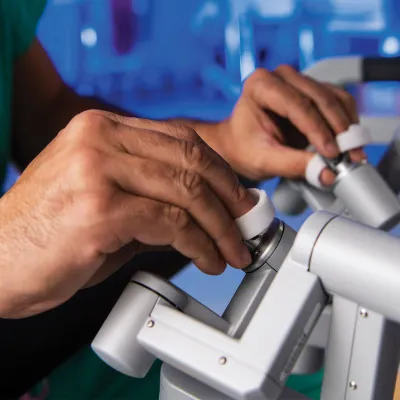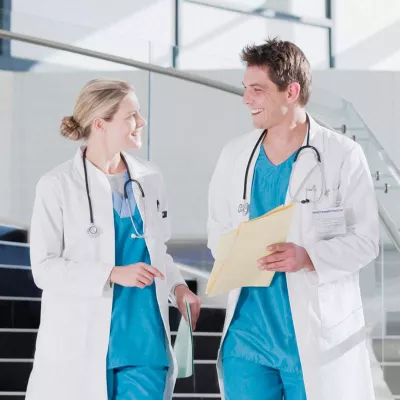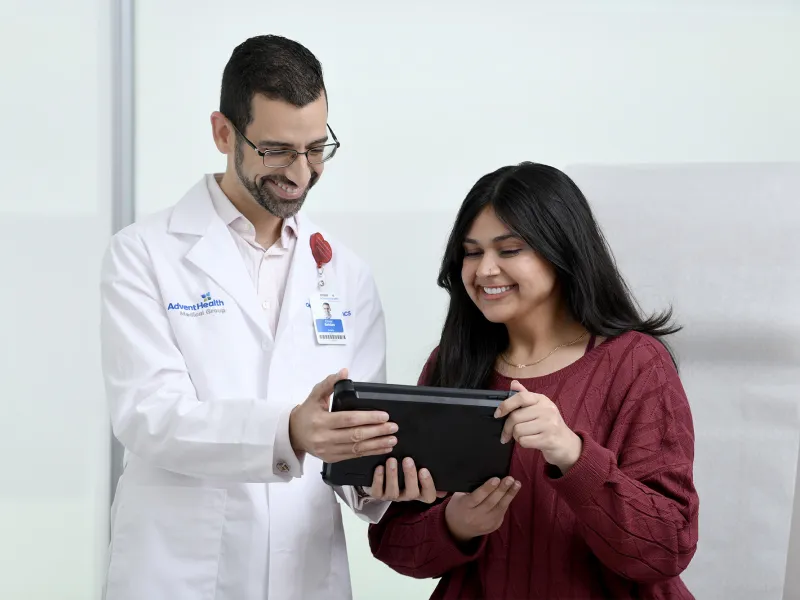
EGD for Esophageal, Stomach and Small Bowel Conditions
The most common endoscopic procedure is an upper endoscopy. This procedure is also called an esophagogastroduodenoscopy (EGD) because it looks at the:
- Esophagus (esophago)
- Stomach (gastro)
- First part of the small intestine (duoden)
When someone speaks of having an “endoscopy,” it usually means this procedure. Upper endoscopy is used to diagnose, monitor, biopsy and treat several digestive conditions.
Whole-Person Care for EDG
Preparing for an upper endoscopy is easy. It involves fasting for a few hours beforehand. Some patients may need to stop taking certain medications a few days before their procedure. When the endoscopy is about to begin, the patient will lie on a bed with his or her head slightly raised on a pillow. The endoscope—a flexible tube with a light and camera—will gently be placed down the patient’s throat and into the esophagus.
Many patients only have their throats numbed so they won’t feel the endoscope, but some prefer light sedation or even general anesthesia. At AdventHealth Digestive Health Institute, we want you to be comfortable during your endoscopy and will work to achieve that. After the endoscope travels through the esophagus, it continues through to the stomach. Then it passes through to the upper part of the small intestine (the duodenum) until it is brought back out of the upper digestive tract. When the endoscopy is over, patients need little-to-no recovery time unless they were sedated or given anesthesia.
An upper endoscopy can help in the diagnosis of several conditions. Some of these include:
- Gastroesophageal reflux disease (GERD)
- Crohn’s disease
- Difficult swallowing (dysphagia)
- Chronic nausea or vomiting
- Chronic indigestion (dyspepsia)
- Bleeding in the upper digestive tract
Upper endoscopy can also be used to monitor certain conditions to determine if they need medical attention:
- Barrett’s esophagus
- Stomach ulcers
- Follow-up after stomach surgery
Sometimes upper endoscopy is used for biopsy by collecting small tissue samples. These samples will be looked at under a microscope to determine if the patient has any suspected conditions such as:
- Esophageal cancer
- Stomach cancer
- Celiac disease
Finally, a doctor can use upper endoscopy as part of another procedure to treat a condition.
Some treatment procedures that use upper endoscopy include:
- Minimally invasive surgery for GERD
- Esophageal dysplasia treatment
- Removing early-stage cancer or precancerous growths such as polyps
- Feeding tube placement
- Correcting stenosis or achalasia
- Draining a pancreatic cyst
- Removing foreign objects from the esophagus
There are some risks involved with upper endoscopy, but they are very rare. These include bleeding, infection and tearing of the digestive tract. Risks for complications increase if a biopsy or treatment procedure is being done as part of the upper endoscopy. However, closely following your doctor’s instructions in preparing for the endoscopy will lower the chance that a problem will occur.
Endoscopy Services
-
Acid Reflux Measuring Tests
Doctors at the AdventHealth Digestive Health Institute use outpatient tests to measure Acid Reflux.
-
Capsule Endoscopy and Deep Enteroscopy
A capsule endoscopy allows doctors to see into the small intestine, which can be important in diagnosis gastrointestinal bleeding, polyps and cancer.
-
Colonoscopy / Flexible Sigmoidoscopy
A colonoscopy or sigmoidoscopy is a way for doctors to see inside the colon and rectum to identify issues and perform biopsies.
-
Endoscopic Retrograde Cholangiopancreatography (ERCP)
Doctors at AdventHealth Digestive Health Institute use ERCP for Pancreas, Gallbladder and Bile Duct Imaging and Advanced Endoscopic Treatment.
-
Endoscopic Ultrasound (EUS)
Endoscopic Ultrasound. Comprehensive health services are offered at the AdventHealth Digestive Health Institute. We are invested in your long-term health goals.
-
High Resolution Anoscopy (HRA)
Colorectal Surgeons at AdventHealth Digestive Health Institute are HRA Providers (High Resolution Anoscopy) for Anal Cancer Screening.
-
Upper Endoscopy / Esophagogastroduodenoscopy (EGD)
An upper endoscopy helps doctors look at the esophagus, stomach and first part of the small intestine and can help diagnose a range of conditions.

Recover Faster With Minimally Invasive and Robotic Surgery
The expert surgeons at the AdventHealth Digestive Health Institute have a large depth of experience in offering minimally invasive surgery.

Meet Your Dedicated Experts
Our specialists are passionate about providing collaborative care that addresses your unique needs and goals while ensuring you feel informed and supported every step of the way. Learn more about our team and their areas of expertise.

Surgical Consultations For Digestive Cancer Without the Wait
Appointments Within Seven Days for Patients with Cancer
At AdventHealth Digestive Health Institute, we know that after being diagnosed with cancer, patients want and often need to begin treatment quickly. So we make it a priority to offer appointments for cancer surgery consultations within five business days, and often earlier.
Patients who are newly diagnosed with cancer, or have just found out they have cancer again, qualify for this priority access. Our surgeons will make themselves available to see you right away, even for a second opinion. We want to help you start your treatment as soon as possible.
Let Us Help You Feel Whole Again
Whether you’re experiencing new symptoms or want a second opinion on a diagnosis, our dedicated digestive health experts are here to help you find answers and a path forward. Request an appointment today to take charge of your health and get the personal support you need.
